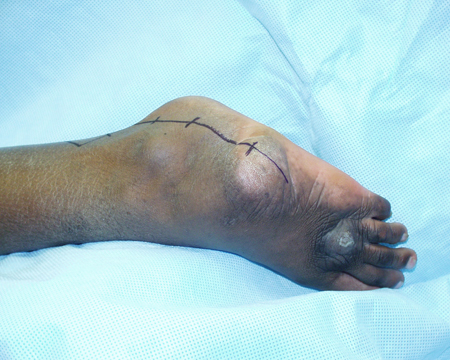Long-term studies demonstrate good to excellent results using non-operative bracing and serial casting (with the Ponseti method) and poorer results with surgical methods.[12]Dobbs MB, Gurnett CA. Update on clubfoot: etiology and treatment. Clin Orthop Relat Res. 2009 May;467(5):1146-53.
https://journals.lww.com/clinorthop/fulltext/2009/05000/update_on_clubfoot__etiology_and_treatment.5.aspx
http://www.ncbi.nlm.nih.gov/pubmed/19224303?tool=bestpractice.com
[13]Ponseti IV, Smoley EN. The classic: congenital club foot: the results of treatment. 1963. Clin Orthop Relat Res. 2009;467:1133-1145.
http://www.springerlink.com/content/70343q11g7v0v72p/fulltext.html
http://www.ncbi.nlm.nih.gov/pubmed/19219519?tool=bestpractice.com
[14]Ponseti IV, Campos J. The classic: observations on pathogenesis and treatment of congenital clubfoot. 1972. Clin Orthop Relat Res. 2009;467:1124-1132.
http://www.springerlink.com/content/623k8t5g112vm276/fulltext.html
http://www.ncbi.nlm.nih.gov/pubmed/19219518?tool=bestpractice.com
[15]Ponseti IV. Treatment of congenital club foot. J Bone Joint Surg Am. 1992;74:448-454.
http://www.ncbi.nlm.nih.gov/pubmed/1548277?tool=bestpractice.com
[29]Ponseti IV. The Ponseti technique for correction of congenital clubfoot. J Bone Joint Surg Am. 2002;84-A:1889-1890.
http://www.ncbi.nlm.nih.gov/pubmed/12377924?tool=bestpractice.com
[31]Noonan KJ, Richards BS. Nonsurgical management of idiopathic clubfoot. J Am Acad Orthop Surg. 2003;11:392-402.
http://www.ncbi.nlm.nih.gov/pubmed/14686824?tool=bestpractice.com
[49]Laaveg SJ, Ponseti IV. Long-term results of treatment of congenital club foot. J Bone Joint Surg Am. 1980;62-A:23-31.
http://www.ncbi.nlm.nih.gov/pubmed/7351412?tool=bestpractice.com
[50]Cooper DM, Dietz FR. Treatment of idiopathic clubfoot: a thirty-year follow-up note. J Bone Joint Surg Am. 1995;77-A:1477-89.
http://www.ncbi.nlm.nih.gov/pubmed/7593056?tool=bestpractice.com
Without treatment, results are uniformly poor, with affected children walking on the dorsum of their feet.
Natural history
The child with an untreated clubfoot begins to walk on the dorsum of the foot. A large callus develops in this region. Painful arthritic changes will continue to develop, leading to a painful deformed foot. In resource-poor settings, people with neglected clubfoot have been described as "condemned to the downward spiral of deformity, disability, dependency, demoralisation, depression, and despair".[44]Staheli L, ed. Clubfoot: Ponseti management, 3rd ed. Seattle, WA: Global HELP; 2009.
http://www.global-help.org/publications/books/help_cfponseti.pdf
[Figure caption and citation for the preceding image starts]: Untreated clubfoot in an adolescentFrom the collection of Scott E. Van Valin [Citation ends].
Ponseti method
Excellent results have been obtained. A 30-year follow-up demonstrated that 78% of Ponseti-treated clubfeet had excellent or good results using pain and functional limitations as outcome criteria. This compares with 85% of a group of people with similar results that did not have clubfoot deformities.[49]Laaveg SJ, Ponseti IV. Long-term results of treatment of congenital club foot. J Bone Joint Surg Am. 1980;62-A:23-31.
http://www.ncbi.nlm.nih.gov/pubmed/7351412?tool=bestpractice.com
Surgical treatment
Surgery gives good function in the first 2 decades of life; later in life, function is poorer. Many patients require repeated surgery, which decreases foot function and quality of life in later years.[12]Dobbs MB, Gurnett CA. Update on clubfoot: etiology and treatment. Clin Orthop Relat Res. 2009 May;467(5):1146-53.
https://journals.lww.com/clinorthop/fulltext/2009/05000/update_on_clubfoot__etiology_and_treatment.5.aspx
http://www.ncbi.nlm.nih.gov/pubmed/19224303?tool=bestpractice.com
